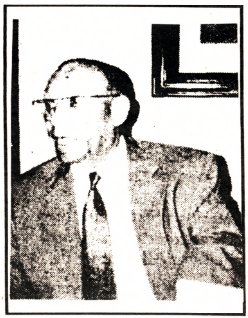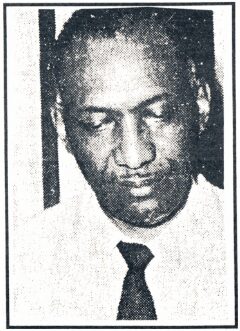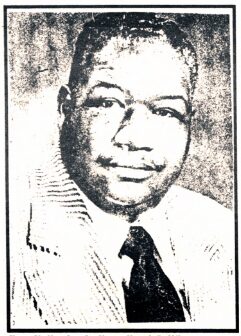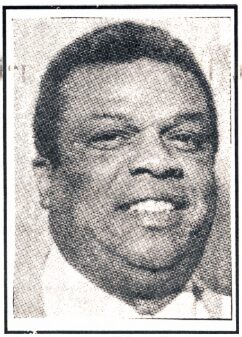[Newspaper]
Publication: The Muncie Times
Muncie, IN, United States
vol. 6, no. 4, p. 14-16, col. 1-5
Depression era is the "Forgotten Years" of Negro Revolution
As the Depression decade of the 1930s drew to a close, the guns of war were firing elsewhere and gradually drawing the United States into World War II.
The fighting in Europe began to stimulate the American economy, but the benefits were not evenly spread, for war-related industries discriminated against Negroes in their hiring practices. The desire for equal opportunity in employment, and even for equal opportunity in offering one’s life for one’s country, made World War II something of a watershed for American Negroes.
When the Japanese attacked at Pearl Harbor in Dec. 7, 1941, and the United States became actively engaged in fighting Japan and Germany, American Negroes found themselves in a curious position. Once again, their country was launched on a crusade to establish the four freedoms on earth, to defeat tyranny and establish democracy; at the same the time, the four freedoms and democracy had not been established here in the United States. As The Crisis of July 1940 expressed it 8 months before Pearl Harbor, "... the hysterical cries of the preachers of democracy for Europe leave us cold. We want democracy in Alabama and Arkansas, in Mississippi and Michigan, in the District of Columbia - in the Senate of the United States."
Many Negro leaders felt that they had been taken in by the slogans of World War I, had eagerly fought for their country, only to see their hopes for a new democratic order smashed by lynchings, riots, and more discrimination. Therefore, from the very outset, national Negro leaders projected the dominant attitude that the Negro must fight for democracy on two fronts — at home and abroad, but particularly at home. This determination to narrow the gap, which the war made so obvious, between the American creed and the reality of continued white supremacy has led historian Richard M. Dalfiume to label the war years, "The ‘Forgotten Years’ of the Negro Revolution."
War-time conditions brought changes in the status quo on the home front: these changes in turn were unsettling and made World War II a time when race relations were anything but quiet. The armed forces remained rigidly segregated; moreover, the areas in which black units were training often were quite hostile to Negro military personnel. Thus the country was treated to the spectacle of men in uniform being assaulted, physically and verbally, by white civilians. There were occasional eruptions amid the tense conditions around military bases. There are Negro World War II veterans in Muncie who recall incidents when extreme discourtesy was directed toward them while they travelled in uniform in the United States.
World War II brought tremendous mobility also. Pressures to produce weapons and other military necessities kept factories working at full capacity. Since over 12 million men were directly serving in uniform, there was a tremendous need for new sources of labor. Thus, the country experienced a major migration toward industrial centers which created a host of growing pains. Industrial jobs previously reserved for whites became available to Negroes; such a lowering, or shifting, of racial barriers offered great potential for racial friction. The housing shortages resulting from these population shifts added significantly to social tensions; there was a constantly moving frontier between black and white housing areas. As a result of all these changes and social pressures, there were a number of race riots, clashes and similar outbursts throughout the United States in the 1940s; these incidents were nearly always started by hostile whites resisting any racial change. Negroes were literally having to fight for democracy on two fronts.
Against this national backdrop, Muncie’s position as an industrial city was fairly typical of other cities nationwide. Accurate population figures are not available for non-census years, so we have to be content with what happened throughout the decade. While Muncie’s total population was growing form [sic] from 49,720 in 1940 to 58,479 in 1950, the Negro population rose from 2,985 to 4,400. Expressed in relative terms, Muncie’s Negro population increased by 47 percent as compared with a mere 8 percent increase in white population.
Such growth was based on improved employment opportunities, due to the greater number of jobs already available to Negroes and to the opening of positions previously closed to them. Wire and steel mills, foundries, and the glass works employed more Negro workers than ever before. In some cases, they even opened their doors to Negro women for the first time. At the same time, progress was very slow in the automotive plants, the major one of which still refused to hire Negro production workers.
During the summer of 1943, the social changes stemming from the war and war-time economy spawned a number of serious racial clashes. Los Angeles and Harlem witnessed upheavals and Detroit was the scene of an ugly riot, which started with white mobs beating up Negroes but ended in Negro retaliation. In Muncie, the economic gains and increased size of the Negro community heightened local tensions, which nearly exploded violently in July 1943.
A Negro youth, Kenneth Thompson, was accused of assaulting Mrs. Helen Humpheyville, 315 N. Hackely, and robbing her of $16. A white mob, reportedly led by several prominent citizens and including the mayor, formed in downtown Muncie and marched on the Thompson home in the 800 block of North Broadway. As the mob approached, many armed Negroes stationed themselves behind buildings and in McCulloch Park. Mr. Thompson drew his weapon, stepped out on his front porch and told the mob that the first person to set foot on his porch would be a dead man. Realizing that the Negro community was prepared for a showdown and that much bloodshed might result, the mob returned downtown and dispersed. Racial tension remained high until the fall, when young Thompson was tried, convicted, and sentenced to 10 to 25 years, the harshest penalty possible for his alleged crime.
The influx of Negroes created housing pressures, particularly in the near southeast, or Industry, section of Muncie. As the color line expanded, it caused considerable consternation of the part of white city fathers. By the summer of 1944, the military situation abroad lead Americans to be confident of victory, so that plans for the post-war economy began to appear. Locally, the Muncie-Delaware County Planning Commission authorized a report, compiled by Realtor Mark D. Miltenberger, titled, "Planning for Post-War and the Future of Muncie," which appeared in August 1944.
One section of this report, "Colored Housing and Allied Problems," provides at least a clue to the prevailing climate of white opinion at that time. After noting that this subject was of vital importance to the growth and welfare of Muncie, and that the proposed program had been thoroughly discussed with "leaders of both white and colored races of our city," the report announced its post-war plan for Muncie’s Negro community. It is best quoted at length:
This is a plan for the betterment of conditions as they affect the colored people and the values of real estate. One of the first things we must do for the colored race is to make their living conditions attractive and healthful. The plans for sewer mains and improved streets are a portion of the definite ideas of our post-war committee.
The Federal Housing Administration will accept applications for and will insure loans made by members of the colored race. This is one of the most advantageous financial plans available and should enable many people, who can quality [sic] qualify, to obtain modem homes.
This financing plan perhaps is the first and most important step in the undertaking; for example, a deal for the construction of five new homes in the northeast corner of Whitely, could be consummated. If these homes are attractive this should give the owners of surrounding real estate an incentive to modernize and repair their properties, thus creating additional desirable housing for colored people. This condition, over a period of time, naturally will spread over this entire section of our city. Most people realize Whitely has the only natural rolling ground in our entire city that is used for residential purposes thus making attractive building sites.
Attention is called to the possibility of including Austin Heights in such a program. This addition is made up of some 220 vacant lots, all of them are 50 feet in width, and are from 138 to 185 feet deep, and 19 modern improved homes. The streets are wide and fairly well improved. Nice shade trees line the cement side walks. Most anyone can visualize a development of modem homes for comfortable living in this section. There is, as well, the possibility of expansion on three sides. Certainly the possibility of having garden spots and spacious lawns is the backbone of American living and should become of the greatest features of stabilization among colored people.
Highland Avenue can be visualized as being a shopping center and it should contain a theatre. New and commodious churches should be a part of the plan in the future. We should plan for both a YMCA and YWCA and an American Legion Home in that locality. Suitable playgounds [sic] playgrounds and a park should be provided some place near the center of the proposed community. Fire and police protection and perhaps a governing body directly responsible to the local city authorities can be developed.
Crime in a district such as this should be at a minimum.
How can this be accomplished? Will the colored people like this sort of an arrangement and how can it be financed? It can be offered only as a plan and made attractive to the people so they will want to move into the section after they have been shown all the advantages of one community. In unity there is strength.
From the financial angle all owners of real estate in this community will profit from the improvement made to surrounding properties and those owning property in other sections of the city will be benefited by the strengthened value caused by the transition. This will make more homes available for an increased white population
To reach the ultimate goal of this planned pattern, a holding company should be formed to finance the outright purchase of Austin Heights and the homes already there. In turn, the lots and the homes can be sold and the money returned to the investor company. Eventually a yield of profits from this organization plus contributions could be used for the placement and construction of churches, the YMCA and the YWCA. Investors, naturally, will be drawn to the business section of this thriving community and before long, new store buildings and a theatre likely will be the result of such a highly developed section.
Volumes might be written and the facts given about the advantages to the colored race of a project of this sort and the effects of it upon the moral character of its people, the housing conditions and the financial strengthening of values of all surrounding real estate.
This plan and pattern is presented as a workable instrument and one of great importance to the colored race. This plan should be pursued for the good of Muncie and so that all of us may have a healthy and happy place in which to live and call our home.
Two white men presented this plan to the Negro community at a mass meeting held in the Odd Fellows building at the corner of Willard and Hackley streets. The hall was packed and, since the night was warm and beautiful, people overflowed into the streets trying to hear what was going on. As the proposal was read, the audience was simply shocked. After the presentation and some questions, several people expressed their disgust at what they deemed a crime against Muncie’s Negro community in the form of a planned ghetto.
This negative reaction to the plan rendered its two spokesmen speechless; lacking any adequate response to these unexpected rebuttals, they were described as having looked for a place to hide. One person remembered, "It seemed there was a dawn of enlightenment that came upon Muncie’s Negro community during the process of that meeting."
The entire plan seemed to be an attempt on the part of white Muncie to collect all Negroes in the Whitely area to make room for a growing white population that could have all the rest City fathers apparently got the message because there were no subsequent efforts to implement this plan.
Examples of segregation are abundant during the 1940s. In Indiana, Crispus Attucks was the only high school for Negroes in Indianapolis and it was only admitted to the Indiana High School Athletic Association in 1942.
In 1947 a number of organization launched a concerted drive to desegregate department stores, restaurants, theatres, lunch counters, hotels, and other public facilities in Indianapolis against stout resistance from these establishments. A law prohibiting school segregation passed the State Legislature finally in 1949.
Muncie’s school had never been segregated so there wasn’t that battle to fight for, but other forms of open discrimination continued. For example, when the highly successful Muncie Central athletic teams travelled out of town, white members stayed in downtown hotels while Negro members were sent to room with "a nice colored family in the colored section."
Moreover, Negro athletes were forced to eat sandwiches on the bus while their white teammates ate in good restaurants. Ball State Teachers College still excluded Negro students from dormitories, as did Indiana University.
An incident involving overt prejudice prompted a letter to the Muncie Star Public Letter Box on April 18, 1949. Mrs. Charles Booher wrote:
If you have not read Patricia Braggs’ letter in the Public Letter Box, April 15, perhaps you, as Muncie citizens, should. This very fine Central High School girl who went to lunch with her French class was told by the waitress at the Varsity Restaurant that coloreds were not served there.
The class was to have a lesson in table manners given by a French student while they were having their lunch. What would you have done if you had been the French teacher? Given Patricia the key to your apartment and have her go there and wait alone, while the rest of you had lunch as the teacher did? Or would you have taken your whole class to your apartment and had your lesson on table manners there?
This teacher then would have been giving a concrete lesson in true democracy. I am sure that as a member of the French Club, Patricia expected more loyalty from her classmates. What do you think? Muncie is certainly trailing far behind in human relations when a teacher will not take a stand for all her pupils regardless of race.
Can you imagine the humiliation in leaving your class and having to walk out of the restaurant alone with all the eyes on your back? Some feeling sorry for you and others not caring one way or the other. It must have been a long walk for Patricia to the door, a walk most of you will never take, I hope. For her then, to go to the teacher’s apartment and wait all alone for her class to have lunch and then join her while she drank a glass of milk. I wonder how she was able to drink? For surely her cup runneth over.
Many cities are making great strides in the field of human relations. Just what is wrong with Muncie? Don’t we all want to see democracy to which we give so much lip service really work? If we do, let’s all pull together and make this a better city for all, regardless of race, creed, or color. If this will help regain in a small way some of the prestige we have lost throughout the world because of our treatment of minorities.
If you really feel you’d like do to something now along this line, fine. Why not really get to know Negroes well? You will no doubt be surprised to find him as human and as real as your next door neighbor. You will find that he is concerned with the same problems of health, happiness and security. Another suggestion: Why not as a club project invite some Negroes to your next meeting? Why not actually notice the Negro who passes you on the street or sits next to you in the movies or on the bus? Notice him! He is no different than you. Try to think of him as a human, with human capacities for suffering, enjoyment, and sorrow. The same human frailities [sic] frailties for pettiness, greed and selfishness. Think of him as a brother, and not of yourself as being superior.
The black YMCA struggled along without any paid staff or real recreational facilities, under the determined leadership of Dr. A. Wayne Brooks. In 1943 the organization rented new quarters at 1431 Willard St. and hired Arnold C. Bannister as full-time director. Within the next few years, Mr. Ralph Warren replaced Mr. Bannister, who moved away from Muncie.
 |
| Coach Harry Evans |
"Y" leaders secured the old Jackson School playground for a permanent site, only to run short of funds and being forced to erect two temporary government buildings there in 1947. After waiting 20 years since their last championship, in 1948 the "Y" Monarchs won the Mid-Western Athletic Association Championship under the guidance of Coach Harry Evans. During that same year, the secretary of the Central YMCA wrote the following brief statement in connection with the 27th anniversary of the colored "Y":
Aims and Views of General Secretary
by H.A. Pettijohn
Over many years, the national boards committee of the YMCA on work among Negro men and boys has performed a continuous and constructive service in guiding the development of one of the most important aspects of the association’s service. Its leadership and capacity have been second to none in the long history of the YMCA movement, just as the total professional staff serving this particular group of associations has consistently represented superior training and high standards of leadership.
The work of the Madison Street Branch in the City of Muncie has been of high order and the Central YMCA has cooperated with this branch in every way. The directors of Madison Street YMCA are men who have given their time and service to carry forward their work among their people.
We are hoping for better facilities for the Negro race in our city, and the Central Branch, with its staff and directors, pledge continued support and cooperation with your program for the Negro men and boys of Muncie.
Perhaps this summed up the attitudes of Muncie’s white leadership.
In 1943, the Afro-American World Almanac appeared, subtitled What Do You Know About Your Race?, containing unusual facts about prominent people of African descent. Its author, Ross D. Brown, had lived in Muncie for many years. In 1905 Mr. Brown had invented and secured three patents for an automatic glass gathering machine.
This machine was used at Corning, New York, at the Skillen Goodin glass factory in Yorktown, and also at the Hemingray Glass Factory in Muncie. Rumors in Muncie’s black community suggested that unscrupulous businessmen flim-flammed young Brown out of the rights to his invention and that he received little or no financial reward as a result.
| |||
| James Tinsley, Ball Brothers union leader |
Disillusioned, Brown eventually left Muncie for Chicago, where he founded and was pastor of Truth Seekers Temple, 417 E. 47th St. In his Almanac, the line "Kitselman Brothers of Indiana, friends of Amanda Smith, the great Negro Evangelist" appears under the title, "Some Fine White Friends." In his foreword the former Muncie resident says:
The Southern Slave owners said we were "Darkies."
The Race baiting crackers called us "Niggers."
The Black Brotherhood said we were "Black People."
The Moorish Americans said we were “Asiatics.
The AME Church founder called us "Africans."
The UNIA says we are "Negroes."
The NAACP says we are "Colored People."
The Holy Bible refers to us as "Ethiopians."
Many newspapers refer to us as a "Group."
And before election, politicians call us "Brothers."
What ever we are, we will soon pass out of existence as a race, unless we stop trying to get something for nothing.
If we fail to remember who we are, we should always remember where we are, and if the men and women of our race continue their vulgarity, profanity, and indecency on the streets and in public areas, if we do not cultivate a higher standard of culture, dignity and refinement, we will soon be pushed off the face of the earth.
Although the 1940s was a time a struggle and although Muncie’s Negroes seemed not to have gained as much ground as might have been hoped, it would not be appropriate to close this section without ending on a hopeful note. Prejudice continued to obstruct employment opportunities for Negroes, yet the war-time economy had opened many doors. In one area, not too often noted, Muncie’s Negroes played a strong leadership role and were instrumental in organizing labor unions within local heavy manufacturing plants.
Prior to the formation of the CIO in the 1930s, mass industrial workers had no organization — the AFL was a craft federation which was not concerned with unskilled or semi-skilled laborers. Consequently, the CIO organized the mass industrial workers, and made a particular effort to attract the Negro laborers, who were comprising an ever-increasing number of factory workers. One method of doing this was to send Negro field representatives and organizers into local plants, a strategy designed to keep race prejudice from blocking effective organization.
| |||
| Dan Kelly, Jr., Indiana Steel & Wire |
In Muncie, the establishment of union locals in the heavy industrial plants owed much to Negro union representatives and to the local Negro work force. This role was recognized by white and black workers alike, who elected Negro union officials. Among some of the Negro union leaders were: James Tinsley, president of Local 93 at Ball Brothers; Frank J. Nelson and Hurley Goodall, both of whom served as president of United Auto Workers Local 532 at Muncie Malleable Foundry; Raymond Pittman, Willard Washington, Ezra Cherry, and Ralph Kersey, each of whom served as president of United Auto Workers Local 609 at the Indiana Foundry; Thomas Phillips at Broderick Company; Arthur Burnam, Sr., at Chevrolet Muncie; Dan Kelly, Jr., Indiana Steel and Wire; and Curly Dinwiddie, Muncie Foundry.
| |||
| Hurley Goodall, UAW Local 532 |
This union leadership has been important in improving job opportunities for Negroes, as well as in upgrading the standard of living of Muncie’s factory workers, both white and black.
If it seems that things had gotten worse for Negroes in Muncie after World War II, this is not the case. But attention given to some of the persistent practices of segregation and discrimination gave evidence that Muncie’s Negro community had higher expectations than ever before. In some ways these years had been a part of the ‘Forgotten Years’ of the Negro revolution.


